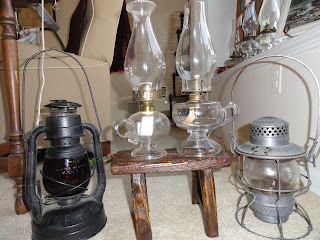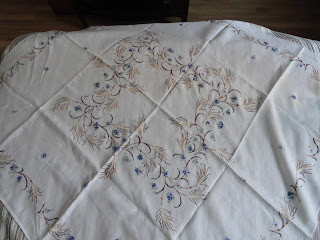This past weekend T's parents drove up from North Carolina and we all made our way three hours north to Lancaster County, Pennsylvania for a weekend of antique shopping and relaxing (really one and the same thing, right?).
We got to the heart of the Amish community in Bird-in-Hand, PA on Friday evening and had dinner at a place called Good and Plenty, which specialized in Pennsylvania Dutch cooking. I will agree with the latter, and won't comment on the former. It is a table service all you can eat place, with three different main courses per night. The night we were there it was fried chicken, roast beef and butter braised (literally) fish. They also said they offered four vegetable dishes per night, but unless the mashed potatoes and buttered noodles qualified as vegetables, I think we got short changed. Anyway, if you wanted to carb load before a long run, this is the place to go.
It was a communal dining room. 10 to a table and each table seated at the same time. So you end up asking total strangers to pass the butter, which wasn't so terribly bad as the people we were seated with were friendly locals. It was a big place.
We stayed at a lovely dog-friendly cottage in Adamstown, PA. The cottage dated back to the 1700s with some of the original brick exterior still visible. Saturday morning dawned sunny and bright and amidst definite signs of spring, we had a leisurely start to our day of trekking through the numerous antique shops.
Adamstown is the self-proclaimed "Antique Capital of the USA" and I am not sure I disagree. Route 272 runs north from Lancaster, PA and crosses the Pennsylvania Turnpike at Denver. From there it is about three miles to Adamstown and that three miles is lined with huge antique malls, basically large venues with 100+ antique dealer spaces under one roof. Added to that are two antique markets that only operate on Sundays and have a total of around 1000 different vendors participating. Heaven on earth for an antique lover. Basically, if you like old junk, you can find whatever it is that suits your fancy in the environs of Adamstown.
I said in an earlier post that one reason I like antique shopping is that I enjoy seeing the character of the region reflected in the trinkets and detritus of the past. As we have gone from state to state across the country, I have been able to trace in some small way the development of our country and its regional differences. I have seen primitive wood carvings and railroad equipment out west, dairy bottles and oil lamps in the Midwest, Civil war artifacts and patchwork quilts in the Shenandoah and in Lancaster County, the simple and sophisticated, yet highly functional ornaments and furnishings of the Pennsylvania Dutch community.
I don't know very much about the Pennsylvania Dutch, only that they are Germanic in origin and that they settled in the Lancaster County area during the first half of the 1700s and that they make really pretty things. Fracturs, the motifs and decorations that are most readily identified with them are brightly colored, often depicting animals and other natural phenomena. In my quest to fill my kitchen with old, hand-crafted and long-lasting cooking utensils, I found a wonderful pie plate still in its original box. Here it is pictured with a reproduction of a fractur, so you can see the way the images have been transmitted through time.
I guess I'll be making an apple pie this weekend to test it out.
Here is another old kitchen item I found that to me is particularly reminiscent of Pennsylvania Dutch designs, open, light and simply done on a white background.
One part of the original Pennsylvania Dutch community that has remained relatively isolated and unchanged throughout time are the Amish. They live separately, yet amongst everyone else and at night their homes are identifiable by their lack of electric lights. During the day their farms appear well-kept and prosperous.
They still share the road in their black horse-drawn buggies. It is always surprising to turn a corner and be caught behind one.
Here, tradition meets modernity.
But back to the antiques. One of the things T likes is light. All kinds work for him, from delicate finger oil lamps, to grimy old railroad lanterns to Colman lanterns, he likes them all. We found some of everything this weekend, along with a primitive handmade footstool that is perfect for me to prop my short legs on as I stitch.
And here is another one that we hung in our screened-in porch. This will be a wonderful light source once the weather warms up and it becomes our primary dining room again.
What I look for in antique stores are things associated with my hobby - sewing and needlework accoutrements. There was an awful lot to be had there this weekend and I literally drowned in linens and handmade lace. To say that I enjoyed myself is an understatement. Here is a typical stall in the Sunday antique market that was more or less dedicated to textiles and the needle arts.
I'll start with the best. Over the weekend, I saw close to 20 antique samplers at the various stalls and shops. I have learned to walk into a place and immediately scan the walls. T too has become an expert sampler stalker on my behalf. I loved every sampler I saw for one reason or another, but it was this one that really held me, and therefore it was this unsigned and undated white work sampler that ultimately came home with us.
Some details. According to the very knowledgeable woman who we bought it from, this sampler is from Lancaster County and was most probably stitched in the 1890s. It is worked on homespun linen with homespun cotton and linen threads. The threads are naturally browned and all told there are about five shades of off-white, ecru and tan on the piece. It is in extremely good shape and the stitching is so incredibly fine it gave me the goose-bumps when I first examined it.
I learned last night that photographing white work samplers is no easy thing, and I hope these close-ups give you a better indication of the level of effort that went into this piece.
I put this up tonight in a central place where I can admire the fine work every day. I am glad that this stitcher's work is in a place where it will be appreciated day in and day out.
Another thing I stumbled upon was a spool cabinet for my multitudes of silk threads. I saw a great many of these this weekend as well, but this one was by far the cheapest, mainly because some of the knobs have been replaced and it needs some restoration work. Still, I think it has character and I am willing to do the work required to bring it back to its original glory. It will be put to good use once I get it cleaned and oiled.
There is more old lace and trim available in Lancaster County than I could ever know what to do with. However, since I used up all the old lace I purchased the last time I was up there in 2009, I went ahead and got some more. While I was at it, I found an old box of cotton perle. The balls used to be white, but have since turned a lovely shade of creamy tan, reminiscent of aged white trim. This entire box cost a scandalous $5, in other words less than a single ball of new white perle.
The shops are also full of old linens. Some are high-quality, fine linen covered with ornate stitching, while others are plain and homespun. I tend to like the density and feel of the homespun linen more. Here is an old tea towel of homespun linen that someone initialed in red.
Another piece I found in the sturdy linen was a 96-inch long table runner. I immediately zeroed in on it because it is stitched in red and brown, my favorite combination, and because it was so reasonably priced. Once we got it back to the cottage my mother-in-law pointed out that I was very lucky to find a piece with my own initials on it. I asked her what she was talking about and she looked at me like I was daft. And sure enough, on one end of the runner is a humongous "H" and on the other, a large "K" (my middle initial). I was stunned. How on earth did I manage to miss that? It was meant to be I guess.
The colors on this runner are so incredibly lovely, although if you look closely you will see that the stitches cross in both directions, which you are always taught not to do. I find it charming here.
T always jokes with me that all the things I stitch and sew will one day end up being dumped at a thrift store or antique shop when I go. I am of two minds about this. On one hand, I would hate for my pieces to be "dumped" anywhere. On the other hand, if they go to shops such as the ones we visited this past weekend, at least I know that at some point someone will pick them up, admire them, be shocked and horrified at the $2 price tag and take them home and treasure them as if they cost $100. That is how I feel about this next piece. It needs some significant stain removal work, but that should be easily accomplished with a good round in oxy bleach. I mean, how can you not love this small runner that simply shouts spring?
This piece is larger, but similar. This is on fine, mercerized linen. The amount of work that went into planning and stitching this is incredible and it is in mint condition, with no holes or stains. For it to be stuck at the bottom of a bin full of linens and sold for $15 is almost criminal. This is a summer piece, all wheat and cornflowers.
And another $2 tea towel, this one made after my own tea-drinking heart.
And I couldn't resist this apron, which I actually wore in the kitchen last night.
Finally, here is something that I will always treasure. It is a schoolgirl's stitching primer. As she learned a new stitch, she attached the fragment of stitching into the book and wrote a description of what she did, complete with spelling and grammar errors. There are about 20 lessons and stitched samples in the book. She signed the opening mini sampler in 1921 and her name was, as you can tell, Kathryn J---k. If someone can figure out her last name, please post a comment. I'd love to do an internet search to see if I can find out more about her.
So there you have it, a wonderful weekend full of old delights. We saw so many lovely things that made us look back with respect and admiration. It is amazing that in a world completely devoid of computers, cell phones, tweets and GPS devices, people filled their lives with such incredibly functional and beautiful pieces of art and furniture that we can still use and admire today.
And I can't get my electric toothbrush to last two years before it needs to be replaced.











































No comments:
Post a Comment